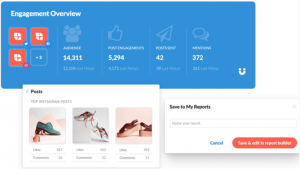Are consumers cooling to social media or are they willing to engage? Here’s where marketers will commit their efforts in the year ahead.
Marketers will continue to engage with audiences on social media through advertising and organic social campaigns. The space continues to diversify, with more user-generated content inspired by the emergence of TikTok in recent years. And for consumers with money to spend, there are new ways to shop through social commerce.
How will these opportunities shake out in the upcoming year? Here are some ways that marketers will leverage social media in 2024.
While customers log off, advertisers will continue to spend and shift their budgets
We’ll believe it when we see it. The reasons why consumers might be turned off to social media are obvious, but they aren’t new. Yet, X saw the grand exit of big tech and entertainment brands last year. It’s not good business to be associated with vile conspiracy theories. As the vitriol ramps up in an election year, will users opt out?
“We don’t anticipate an immediate mass abandonment amongst social users, but rather the potential for a minimization of engagement,” said Dan Gutter, analyst for Gartner. “It would be unlikely for consumers to stop using social media altogether in short order.”
Gartner recently projected 50% of consumers would “abandon or significantly limit their interactions” with social media by 2025. In a Gartner survey last summer, 53% of consumers said social media had gotten worse in the previous year or over the last five years.
“That said, if marketers do notice drops in engagement in the coming year, other digital channels such as digital video or streaming, as well as SEO investment, would be candidates to take up some of that channel space,” Gutter said.
YouTube might offer a refuge
If consumer apathy takes root generally across social media, as Gartner predicts, YouTube might prove more durable than the norm.
“YouTube is an example of a social platform where consumers are potentially more accepting,” said Gutter. “Gartner data shows that nearly a third (31%) of social media users expressed openness to advertising on YouTube specifically. Social users’ top types of branded content on social channels include content that is meant to entertain (47%) and educational content (42%) — both are content types YouTube specializes in.”
He added: “Ad fatigue remains a persistent issue for marketers on social. Gartner consumer data shows that total ad avoidance (e.g. consumers outright abandoning an app/website if asked to allow data tracking) rose from 20% to 33% between 2021 and 2023.”
Social media commands brand-to-consumer interactions
Regardless of potential ad fatigue and brand safety issues, social media will remain a top digital media investment for many brands.
“With the monumental shifts happening within digital [media] due to platform fragmentation, emerging technologies like genAI and evolving consumer behaviors and preferences, social is the nexus of brand-to-consumer interaction,” said Cristina Lawrence, EVP of consumer and content experience at agency Razorfish. “It’s a shift in how brands and businesses approach their relationships with customers, emphasizing engagement, relevance and delivering moments of value in exchange for a wellspring of data around consumer preferences, behaviors, interests and engagements. For the modern marketer, recognizing and harnessing this shift in 2024 is paramount.”
Short-form organic content on TikTok has led to a paradigm shift in social media engagement, offering new opportunities for established brands and newcomers alike.
“By integrating social within the overall strategy, brands can leverage the unique strengths and audiences of these diverse platforms, ensuring a cohesive and effective marketing presence demonstrated through memorable creative content and experiences that resonate with a broad range of consumers,” said Lawrence.
Longer-form video formats on Instagram Reels, as well as TikTok, enable deeper storytelling, Lawrence added.
Smaller communities and sharper focus on audience
“With the overwhelming vastness and noise of the internet, people have been carving out community spaces that feel more manageable,” said Arianna Crawford, social media manager at Big Valley Marketing, a California-based consultancy.
“You see this with the rise of ‘fediverse platforms’ like Mastodon and Bluesky, or with most Instagram users spending a majority of their time in the Stories feature rather than in feed,” Crawford said. “As people make these smaller spaces, the brand strategy of amplifying one post to everyone on one or two platforms becomes more obsolete.”
Crawford mentioned three key improvements that marketers will execute on social in 2024 and beyond:
- Better understand and prioritize their audience segments.
- Get a better hold on what content the audience is looking for, and where.
- Hire more staff that specializes in audience development on social platforms.
Social VR establishes a core audience
Sales of VR and AR hardware dropped 40% in 2023. However, Apple will debut the much-anticipated Vision Pro headset in the year ahead.
“Key players will have a vested interest in attracting and engaging audiences in-experience with their hardware, and it’s possible that there could be opportunities for brands to experiment in partnership with the platforms as early adopters,” said Lawrence.
“Already, for relatively niche audiences, there are select active engagers in experiences like [virtual platform] VRChat,” Lawrence explained. “In 2024, community interactions will continue to operate at a small scale of exploratory experiments in which brands can engage. There will need to be significant adoption before social VR requires more scaled investment from brands.”
Lawrence added: “Opening the aperture wider, gaming experiences — which include, but can expand far beyond marquee platforms like Roblox — offer plenty of opportunities for brand integrations and engagements with connected gamer audiences.”
Social commerce ads remain unshoppable for most consumers
TikTok launched its TikTok Shop feature in 2023, following Instagram and other social media platforms that offer social commerce. True, social commerce offers another shopping option for digital users. But at the same time, ecommerce giant Amazon is growing its ad network. And brands are adopting multichannel selling strategies in addition to shoppable ads on social. This explains why shoppable ads won’t get over the hump in 2024.
“Shoppable ads are still relatively new to most consumers,” said Chad Engelgau, CEO and President of multichannel marketing technology company Acxiom. “In our recently released research, ‘Where Marketing and AI Collide,’ we found that while 62% of consumers were aware of them, only 17% have made a purchase through shoppable social media. In addition, any less-than-ideal customer experiences could redirect consumers to more trusted pathways, like conventional search engines and retail media networks.”
He added, “The digital commerce domain continues to expand, including direct-path-to-purchase in a variety of content forms like display, video, and messaging. This paradigm shift can be compared to the prevailing Amazon model – integrate purchasing and advertising everywhere you can. Amazon is expected to capture 12.4% of all U.S. digital advertising spend in 2023, and is growing advertising by offering ads in video, live sports, audio and grocery.”
The numbers indicate that consumer adoption of social commerce has remained flat over the last two years, and is down from 2021, according to Gutter. Gartner Consumer Data found adoption at 8% of social users in 2023, 7% in 2022 — both years down from 14% adoption in 2021.
“One could argue that consumer interest isn’t necessarily growing at the moment,” said Gutter.
The post 2024 Predictions: Social media’s evolution appeared first on MarTech.
MarTech(23)
Report Post






